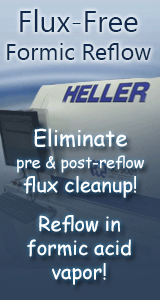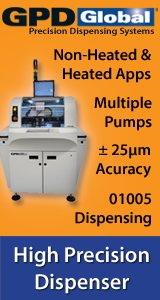Below is the long explanation. This defect is most commonly found with BGA components, but can arrise with all components. I see it happening more now with lead free boards that are being assembled with a no clean flux. Best short term remedy is to touch up the affected solder joint, and or SM pad with a high pH waver solder flux like Kester 2331ZX. Long term remedy is to tell your fab house to fix the problem, and or use a high pH flux in your assembly process.
Written by: Dennis O’Donnell Precision PCB Services, Inc. 1750 Mitchell Ave., Oroville, CA 95966
Exert from the book: BGA Rework Made Simple © 2006
Black Pad - One of the most common problems that result in mysterious opens on BGA components is “Black Pad”. “Black Pad” primarily affects BGA components and will occur when using electroless nickel/immersion gold finishes on the circuit board fab. It is not visually evident on the bare fab and is usually detected after the failed BGA has been removed.
The cause of this is due is a layer of oxidation that prevents electrical connection to the circuit board. When an ENIG surface finished PWB undergoes soldering, the solder must adhere to the underlying electroless nickel plate. This is because the immersion gold is so thin that all of the gold dissolves into the solder upon soldering. The solder bonds directly to the electroless nickel.
If that nickel surface is contaminated in some way, the resulting joint will be weak and the location of failure will be directly below the surface of the nickel by leaving both nickel and phosphorous (a normal constituent of electroless nickel) on both the pad and the failed solder joint surface.
"Black Pad" is a defect related to ENIG boards. It is a separation of solder joints formed to the surface of the electroless nickel underplate. This is commonly attributed to excessive phosphorous in the electroless nickel (i.e. nickel electroless bath out of control). However, any kind of nickel contamination (phosphorous or not) that results in the failures characterized here, are often reported as "black pad" failures.
In short, “Black Pad” is caused by too much phosphorus, and or contamination in the nickel plating bath. It is not visually detected prior to assembly because gold is plated over the nickel.
Indications of “Black Pad” Once you have assembled your BGA to the board. The Xray image looks excellent with uniform balls, no bridging, and minimal voids. You have done a visual inspection of the perimeter BGA balls at 20X and observed uniform ball compression and good wetting. Everything looks good, but the BGA tests with an electrical open, intermittent opens, and or will work if you exert pressure on the chip. This is s sign of possible black pad. If it were cold solder, or insufficient reflow. That would most likely be evidenced during the visual perimeter inspection. At this point you may remove the suspect component and inspect the surface finish on the circuit board and on the BGA. “Black Pad” will appear as a dull grainy black or grey color pad with evidence of non-wetting or de-wetting.
© 2006
reply »
![]() Hi
Anyone encounter this type of reflow issue before?
...
- Apr 29, 2011
by
city4497s
Hi
Anyone encounter this type of reflow issue before?
...
- Apr 29, 2011
by
city4497s
![]()
![]()
![]() Is it possibly being caused by surface contaminants on your ...
- Apr 29, 2011
by
A Very Frazzled Man
Is it possibly being caused by surface contaminants on your ...
- Apr 29, 2011
by
A Very Frazzled Man
![]()
![]() It a recent occurance and it happen randomly on other area. ...
- May 03, 2011
by
city4497s
It a recent occurance and it happen randomly on other area. ...
- May 03, 2011
by
city4497s
![]()
![]()
![]() Can we talk some to better understand the scope and breadth ...
- May 03, 2011
by
davef
Can we talk some to better understand the scope and breadth ...
- May 03, 2011
by
davef
![]()
![]()
![]() Hi Davef
The problem shows up on
* random location includ...
- May 05, 2011
by
city4497s
Hi Davef
The problem shows up on
* random location includ...
- May 05, 2011
by
city4497s
![]()
![]()
![]() Where black pad exists, it is not a common problem. When I r...
- May 05, 2011
by
KaHrpr
Where black pad exists, it is not a common problem. When I r...
- May 05, 2011
by
KaHrpr
![]()
![]()
![]() This appears to be black-pad and is often the result of usin...
- May 13, 2011
by
eezday
This appears to be black-pad and is often the result of usin...
- May 13, 2011
by
eezday
![]()







